Comprehensive Analysis of ALDI's Management and Leadership Strategies
VerifiedAdded on 2019/12/28
|10
|2831
|696
Report
AI Summary
This report offers a comprehensive analysis of ALDI's management and operational strategies. It begins with an introduction to ALDI's organizational structure, including regional, functional, departmental, and general managers. The report then differentiates between the roles of managers and leaders, highlighting responsibilities such as hiring, performance management, and communication, while also exploring the differences between management and leadership. It delves into various leadership and management approaches, including traits theory, behavioral theory, contingency theory, and the classical, behavioral, and modern approaches to management. Furthermore, the report applies chaos theory and management by objectives to ALDI's operations, assessing their impacts on organizational performance. It then examines the influence of leaders and managers on the organization. The report further explores the roles and characteristics of leaders and managers, and how these roles apply to various situations within the organization. Finally, it discusses different leadership theories and approaches, such as situational, systems, and contingency leadership, to provide a holistic understanding of ALDI's management practices.
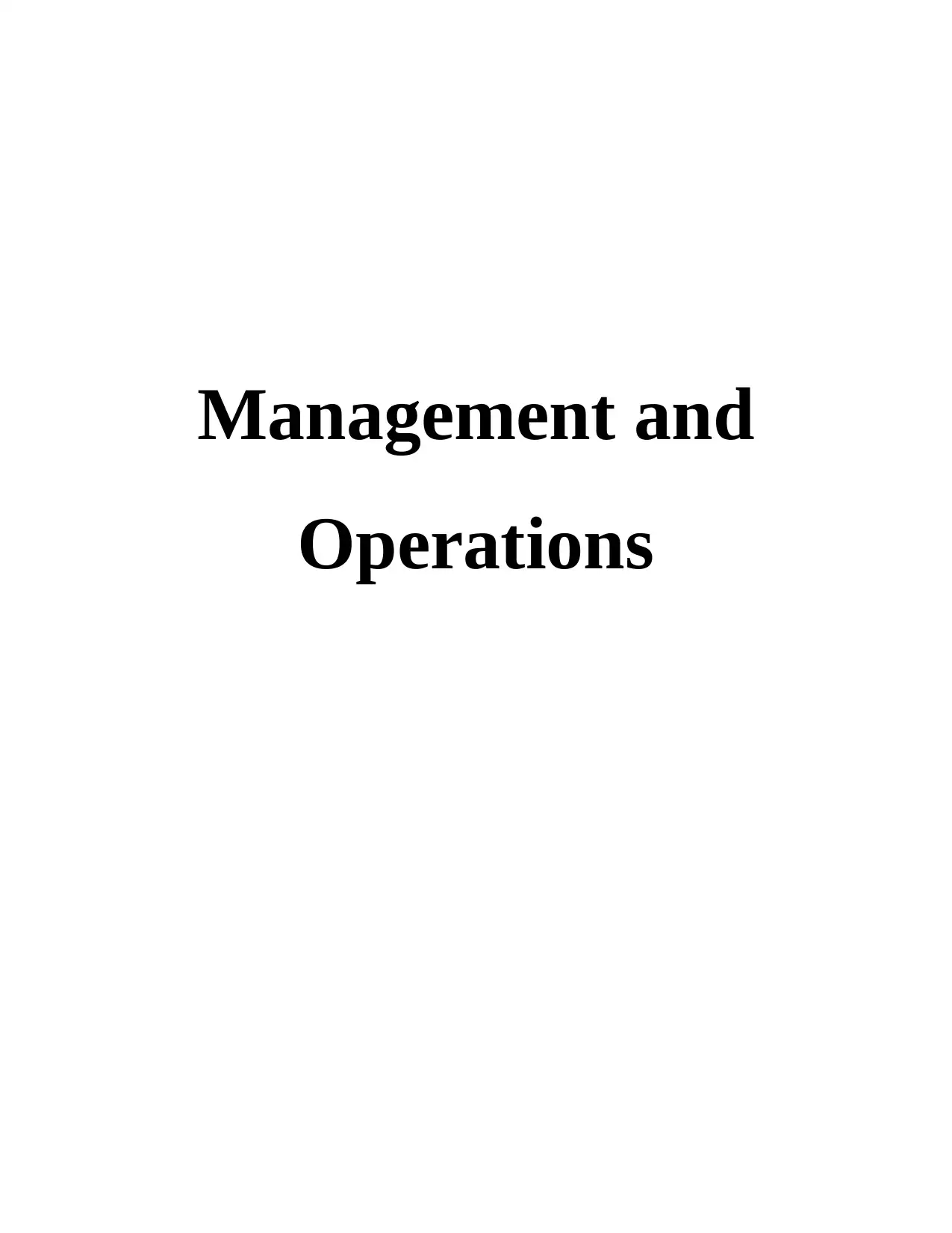
Management and
Operations
Operations
Paraphrase This Document
Need a fresh take? Get an instant paraphrase of this document with our AI Paraphraser
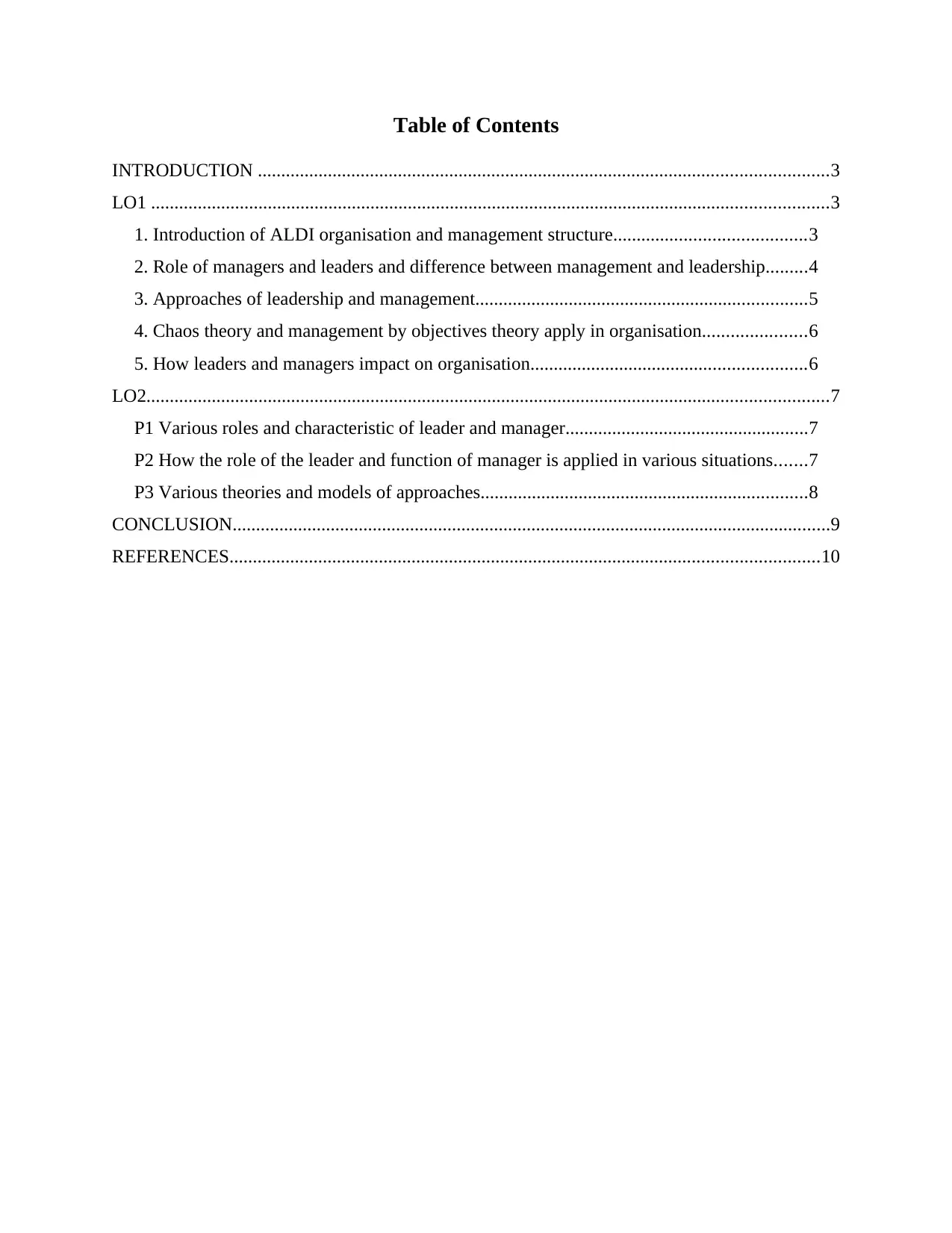
Table of Contents
INTRODUCTION ..........................................................................................................................3
LO1 .................................................................................................................................................3
1. Introduction of ALDI organisation and management structure.........................................3
2. Role of managers and leaders and difference between management and leadership.........4
3. Approaches of leadership and management.......................................................................5
4. Chaos theory and management by objectives theory apply in organisation......................6
5. How leaders and managers impact on organisation...........................................................6
LO2..................................................................................................................................................7
P1 Various roles and characteristic of leader and manager....................................................7
P2 How the role of the leader and function of manager is applied in various situations.......7
P3 Various theories and models of approaches......................................................................8
CONCLUSION................................................................................................................................9
REFERENCES..............................................................................................................................10
INTRODUCTION ..........................................................................................................................3
LO1 .................................................................................................................................................3
1. Introduction of ALDI organisation and management structure.........................................3
2. Role of managers and leaders and difference between management and leadership.........4
3. Approaches of leadership and management.......................................................................5
4. Chaos theory and management by objectives theory apply in organisation......................6
5. How leaders and managers impact on organisation...........................................................6
LO2..................................................................................................................................................7
P1 Various roles and characteristic of leader and manager....................................................7
P2 How the role of the leader and function of manager is applied in various situations.......7
P3 Various theories and models of approaches......................................................................8
CONCLUSION................................................................................................................................9
REFERENCES..............................................................................................................................10
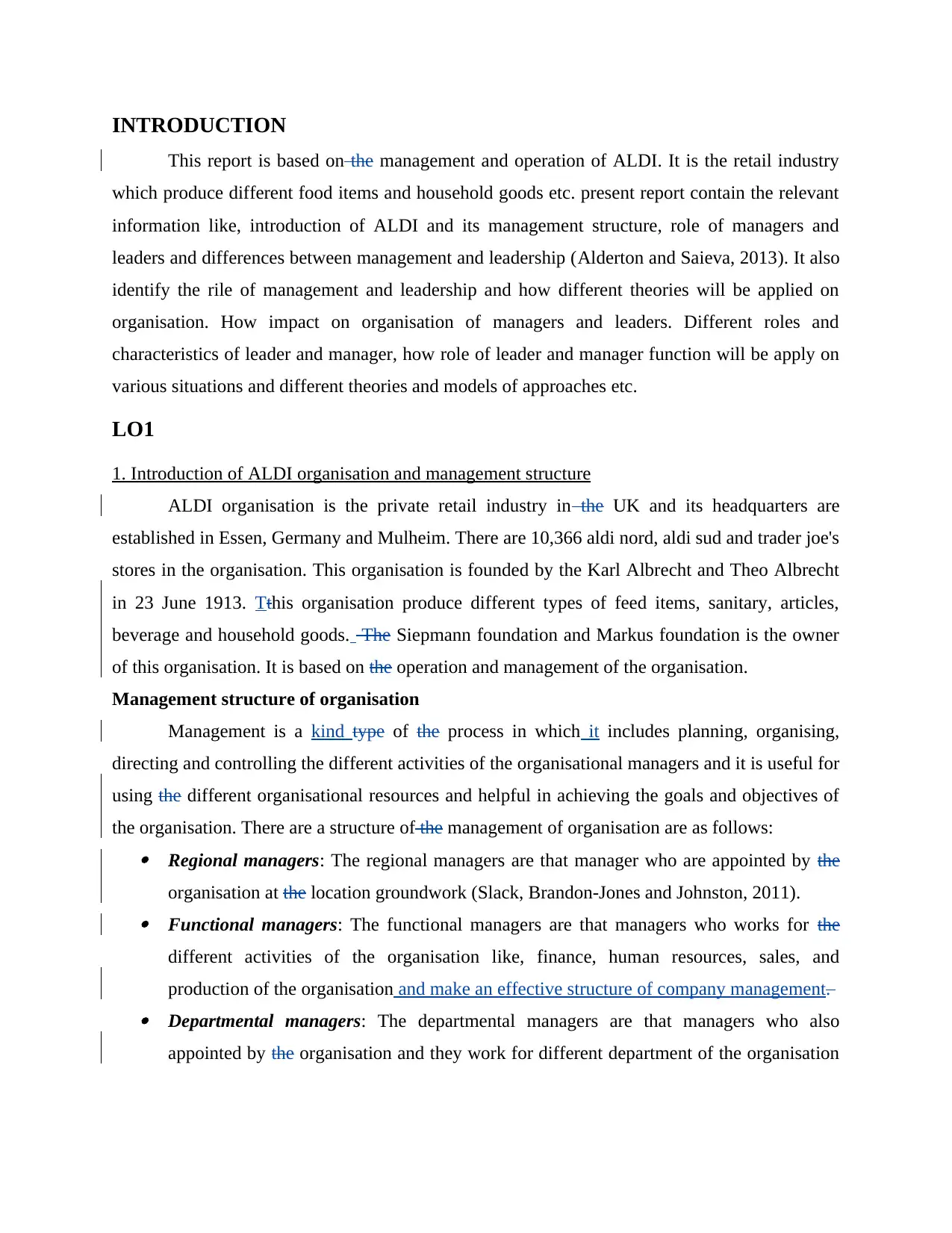
INTRODUCTION
This report is based on the management and operation of ALDI. It is the retail industry
which produce different food items and household goods etc. present report contain the relevant
information like, introduction of ALDI and its management structure, role of managers and
leaders and differences between management and leadership (Alderton and Saieva, 2013). It also
identify the rile of management and leadership and how different theories will be applied on
organisation. How impact on organisation of managers and leaders. Different roles and
characteristics of leader and manager, how role of leader and manager function will be apply on
various situations and different theories and models of approaches etc.
LO1
1. Introduction of ALDI organisation and management structure
ALDI organisation is the private retail industry in the UK and its headquarters are
established in Essen, Germany and Mulheim. There are 10,366 aldi nord, aldi sud and trader joe's
stores in the organisation. This organisation is founded by the Karl Albrecht and Theo Albrecht
in 23 June 1913. Tthis organisation produce different types of feed items, sanitary, articles,
beverage and household goods. The Siepmann foundation and Markus foundation is the owner
of this organisation. It is based on the operation and management of the organisation.
Management structure of organisation
Management is a kind type of the process in which it includes planning, organising,
directing and controlling the different activities of the organisational managers and it is useful for
using the different organisational resources and helpful in achieving the goals and objectives of
the organisation. There are a structure of the management of organisation are as follows: Regional managers: The regional managers are that manager who are appointed by the
organisation at the location groundwork (Slack, Brandon-Jones and Johnston, 2011). Functional managers: The functional managers are that managers who works for the
different activities of the organisation like, finance, human resources, sales, and
production of the organisation and make an effective structure of company management. Departmental managers: The departmental managers are that managers who also
appointed by the organisation and they work for different department of the organisation
This report is based on the management and operation of ALDI. It is the retail industry
which produce different food items and household goods etc. present report contain the relevant
information like, introduction of ALDI and its management structure, role of managers and
leaders and differences between management and leadership (Alderton and Saieva, 2013). It also
identify the rile of management and leadership and how different theories will be applied on
organisation. How impact on organisation of managers and leaders. Different roles and
characteristics of leader and manager, how role of leader and manager function will be apply on
various situations and different theories and models of approaches etc.
LO1
1. Introduction of ALDI organisation and management structure
ALDI organisation is the private retail industry in the UK and its headquarters are
established in Essen, Germany and Mulheim. There are 10,366 aldi nord, aldi sud and trader joe's
stores in the organisation. This organisation is founded by the Karl Albrecht and Theo Albrecht
in 23 June 1913. Tthis organisation produce different types of feed items, sanitary, articles,
beverage and household goods. The Siepmann foundation and Markus foundation is the owner
of this organisation. It is based on the operation and management of the organisation.
Management structure of organisation
Management is a kind type of the process in which it includes planning, organising,
directing and controlling the different activities of the organisational managers and it is useful for
using the different organisational resources and helpful in achieving the goals and objectives of
the organisation. There are a structure of the management of organisation are as follows: Regional managers: The regional managers are that manager who are appointed by the
organisation at the location groundwork (Slack, Brandon-Jones and Johnston, 2011). Functional managers: The functional managers are that managers who works for the
different activities of the organisation like, finance, human resources, sales, and
production of the organisation and make an effective structure of company management. Departmental managers: The departmental managers are that managers who also
appointed by the organisation and they work for different department of the organisation
⊘ This is a preview!⊘
Do you want full access?
Subscribe today to unlock all pages.

Trusted by 1+ million students worldwide
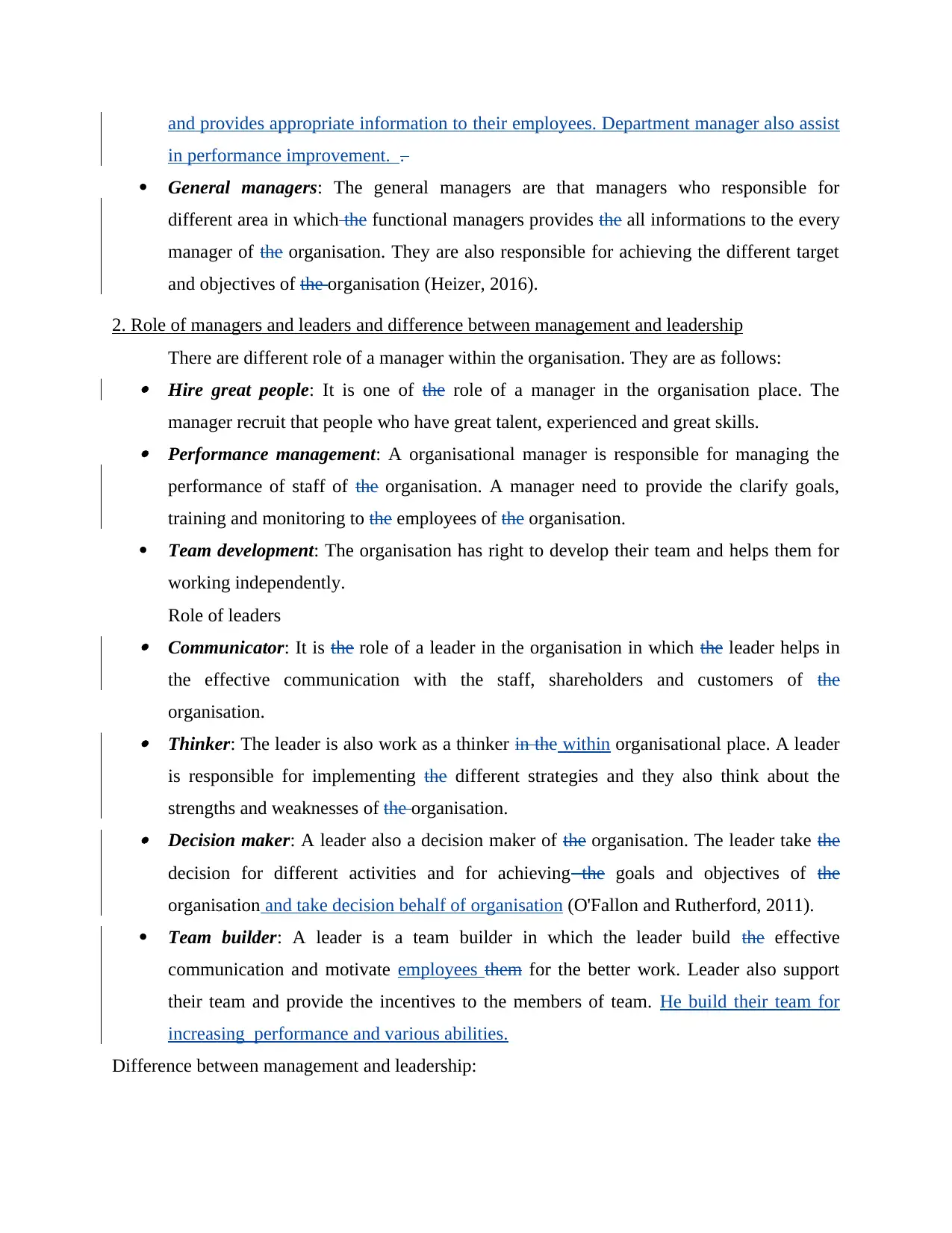
and provides appropriate information to their employees. Department manager also assist
in performance improvement. .
General managers: The general managers are that managers who responsible for
different area in which the functional managers provides the all informations to the every
manager of the organisation. They are also responsible for achieving the different target
and objectives of the organisation (Heizer, 2016).
2. Role of managers and leaders and difference between management and leadership
There are different role of a manager within the organisation. They are as follows: Hire great people: It is one of the role of a manager in the organisation place. The
manager recruit that people who have great talent, experienced and great skills. Performance management: A organisational manager is responsible for managing the
performance of staff of the organisation. A manager need to provide the clarify goals,
training and monitoring to the employees of the organisation.
Team development: The organisation has right to develop their team and helps them for
working independently.
Role of leaders Communicator: It is the role of a leader in the organisation in which the leader helps in
the effective communication with the staff, shareholders and customers of the
organisation. Thinker: The leader is also work as a thinker in the within organisational place. A leader
is responsible for implementing the different strategies and they also think about the
strengths and weaknesses of the organisation. Decision maker: A leader also a decision maker of the organisation. The leader take the
decision for different activities and for achieving the goals and objectives of the
organisation and take decision behalf of organisation (O'Fallon and Rutherford, 2011).
Team builder: A leader is a team builder in which the leader build the effective
communication and motivate employees them for the better work. Leader also support
their team and provide the incentives to the members of team. He build their team for
increasing performance and various abilities.
Difference between management and leadership:
in performance improvement. .
General managers: The general managers are that managers who responsible for
different area in which the functional managers provides the all informations to the every
manager of the organisation. They are also responsible for achieving the different target
and objectives of the organisation (Heizer, 2016).
2. Role of managers and leaders and difference between management and leadership
There are different role of a manager within the organisation. They are as follows: Hire great people: It is one of the role of a manager in the organisation place. The
manager recruit that people who have great talent, experienced and great skills. Performance management: A organisational manager is responsible for managing the
performance of staff of the organisation. A manager need to provide the clarify goals,
training and monitoring to the employees of the organisation.
Team development: The organisation has right to develop their team and helps them for
working independently.
Role of leaders Communicator: It is the role of a leader in the organisation in which the leader helps in
the effective communication with the staff, shareholders and customers of the
organisation. Thinker: The leader is also work as a thinker in the within organisational place. A leader
is responsible for implementing the different strategies and they also think about the
strengths and weaknesses of the organisation. Decision maker: A leader also a decision maker of the organisation. The leader take the
decision for different activities and for achieving the goals and objectives of the
organisation and take decision behalf of organisation (O'Fallon and Rutherford, 2011).
Team builder: A leader is a team builder in which the leader build the effective
communication and motivate employees them for the better work. Leader also support
their team and provide the incentives to the members of team. He build their team for
increasing performance and various abilities.
Difference between management and leadership:
Paraphrase This Document
Need a fresh take? Get an instant paraphrase of this document with our AI Paraphraser

A manager is responsible for the reproduce and the leader is responsible for arsing in the
organisation.
A manger make the things right and a leader make the right things in the organisational
place.
The organisational manager is the good worker and the organisational leader is the own
person and decision maker of the organisation (Talk, 2016).
3. Approaches of leadership and management
There are different approaches of the leadership which is effective and efficient within
the organisational place. The approachesy are as follows: Traits theory: It is the one of classical theory of the leadership in which the behaviour of
the leader is made for the effective qualities within the organisation. The effective leaders
have the different traits like, better personality, ability to take appropriate decision,
reliability, intellectually sounds and ability in effective work etc. This approach focuses
on mental, physical and traits personality for leadership possess that cannot be ineffective
and non-leaders possess. Behavioural theory: This theory is based on the behaviour the leader towards their all
organisational employees. In the behavioural theory, the leader is able to make
communication between their employees and set the clear vision within the organisation.
This focuses on particular behaviour which make difference between leaders and non-
leaders
Contingency theory: This theory is based on the dependency of the leaders and it has
influenced for the different activities of the organisation. There are various determinants
like, budgeting deficient resources, motivating subordinates and different communication
sources etc.
Approaches of management:
There are different kinds of approaches of the management which includes, classical,
behavioural and modern approaches of the management. They are as follows: Classical: The management classical approach is helps in focuses on the productivity of
the individuals employees, focuses on the administration management of the organisation
and also concentration on the overall system of the organisation (Baldwin, Allen and
Ridgway, 2010).
organisation.
A manger make the things right and a leader make the right things in the organisational
place.
The organisational manager is the good worker and the organisational leader is the own
person and decision maker of the organisation (Talk, 2016).
3. Approaches of leadership and management
There are different approaches of the leadership which is effective and efficient within
the organisational place. The approachesy are as follows: Traits theory: It is the one of classical theory of the leadership in which the behaviour of
the leader is made for the effective qualities within the organisation. The effective leaders
have the different traits like, better personality, ability to take appropriate decision,
reliability, intellectually sounds and ability in effective work etc. This approach focuses
on mental, physical and traits personality for leadership possess that cannot be ineffective
and non-leaders possess. Behavioural theory: This theory is based on the behaviour the leader towards their all
organisational employees. In the behavioural theory, the leader is able to make
communication between their employees and set the clear vision within the organisation.
This focuses on particular behaviour which make difference between leaders and non-
leaders
Contingency theory: This theory is based on the dependency of the leaders and it has
influenced for the different activities of the organisation. There are various determinants
like, budgeting deficient resources, motivating subordinates and different communication
sources etc.
Approaches of management:
There are different kinds of approaches of the management which includes, classical,
behavioural and modern approaches of the management. They are as follows: Classical: The management classical approach is helps in focuses on the productivity of
the individuals employees, focuses on the administration management of the organisation
and also concentration on the overall system of the organisation (Baldwin, Allen and
Ridgway, 2010).
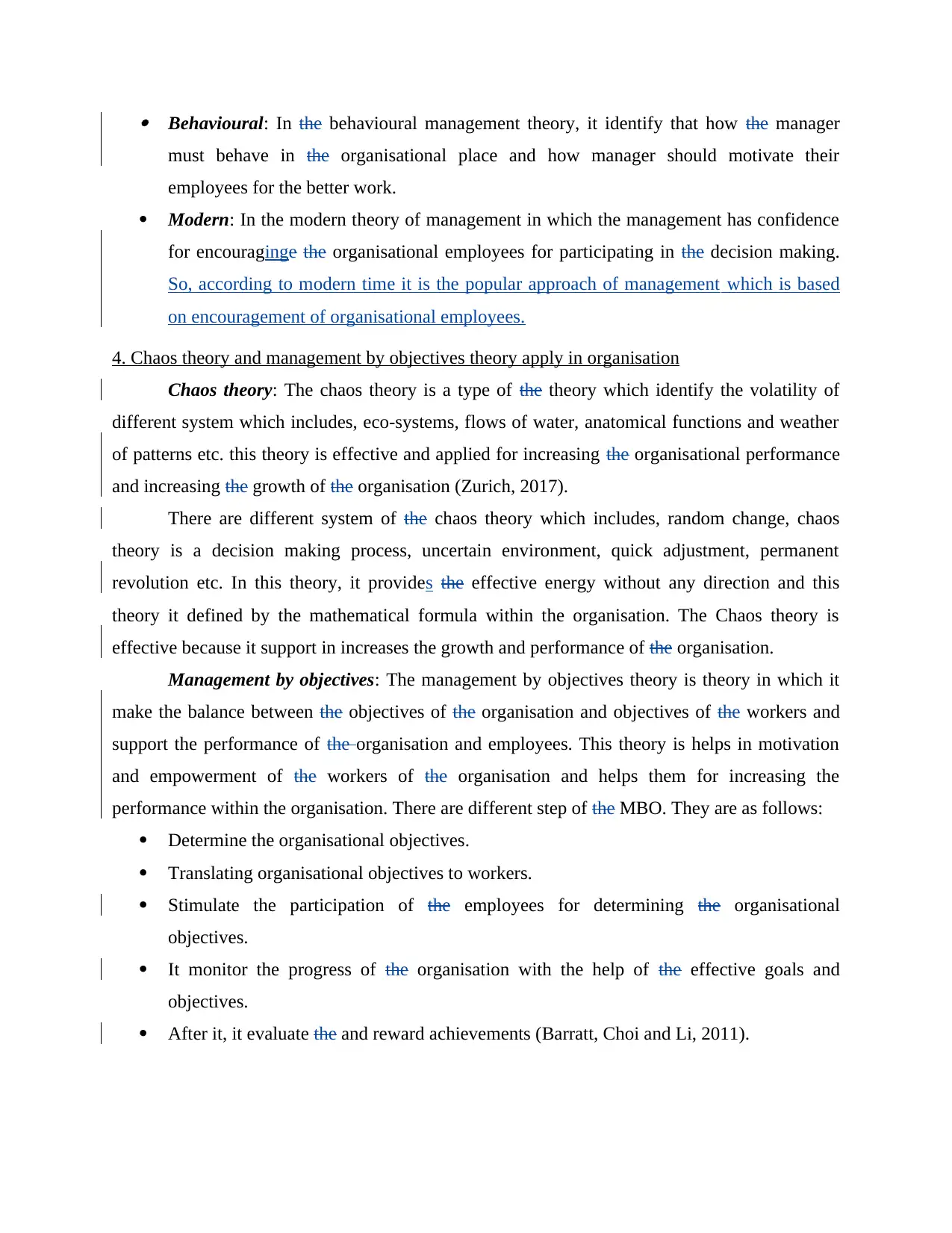
Behavioural: In the behavioural management theory, it identify that how the manager
must behave in the organisational place and how manager should motivate their
employees for the better work.
Modern: In the modern theory of management in which the management has confidence
for encouraginge the organisational employees for participating in the decision making.
So, according to modern time it is the popular approach of management which is based
on encouragement of organisational employees.
4. Chaos theory and management by objectives theory apply in organisation
Chaos theory: The chaos theory is a type of the theory which identify the volatility of
different system which includes, eco-systems, flows of water, anatomical functions and weather
of patterns etc. this theory is effective and applied for increasing the organisational performance
and increasing the growth of the organisation (Zurich, 2017).
There are different system of the chaos theory which includes, random change, chaos
theory is a decision making process, uncertain environment, quick adjustment, permanent
revolution etc. In this theory, it provides the effective energy without any direction and this
theory it defined by the mathematical formula within the organisation. The Chaos theory is
effective because it support in increases the growth and performance of the organisation.
Management by objectives: The management by objectives theory is theory in which it
make the balance between the objectives of the organisation and objectives of the workers and
support the performance of the organisation and employees. This theory is helps in motivation
and empowerment of the workers of the organisation and helps them for increasing the
performance within the organisation. There are different step of the MBO. They are as follows:
Determine the organisational objectives.
Translating organisational objectives to workers.
Stimulate the participation of the employees for determining the organisational
objectives.
It monitor the progress of the organisation with the help of the effective goals and
objectives.
After it, it evaluate the and reward achievements (Barratt, Choi and Li, 2011).
must behave in the organisational place and how manager should motivate their
employees for the better work.
Modern: In the modern theory of management in which the management has confidence
for encouraginge the organisational employees for participating in the decision making.
So, according to modern time it is the popular approach of management which is based
on encouragement of organisational employees.
4. Chaos theory and management by objectives theory apply in organisation
Chaos theory: The chaos theory is a type of the theory which identify the volatility of
different system which includes, eco-systems, flows of water, anatomical functions and weather
of patterns etc. this theory is effective and applied for increasing the organisational performance
and increasing the growth of the organisation (Zurich, 2017).
There are different system of the chaos theory which includes, random change, chaos
theory is a decision making process, uncertain environment, quick adjustment, permanent
revolution etc. In this theory, it provides the effective energy without any direction and this
theory it defined by the mathematical formula within the organisation. The Chaos theory is
effective because it support in increases the growth and performance of the organisation.
Management by objectives: The management by objectives theory is theory in which it
make the balance between the objectives of the organisation and objectives of the workers and
support the performance of the organisation and employees. This theory is helps in motivation
and empowerment of the workers of the organisation and helps them for increasing the
performance within the organisation. There are different step of the MBO. They are as follows:
Determine the organisational objectives.
Translating organisational objectives to workers.
Stimulate the participation of the employees for determining the organisational
objectives.
It monitor the progress of the organisation with the help of the effective goals and
objectives.
After it, it evaluate the and reward achievements (Barratt, Choi and Li, 2011).
⊘ This is a preview!⊘
Do you want full access?
Subscribe today to unlock all pages.

Trusted by 1+ million students worldwide
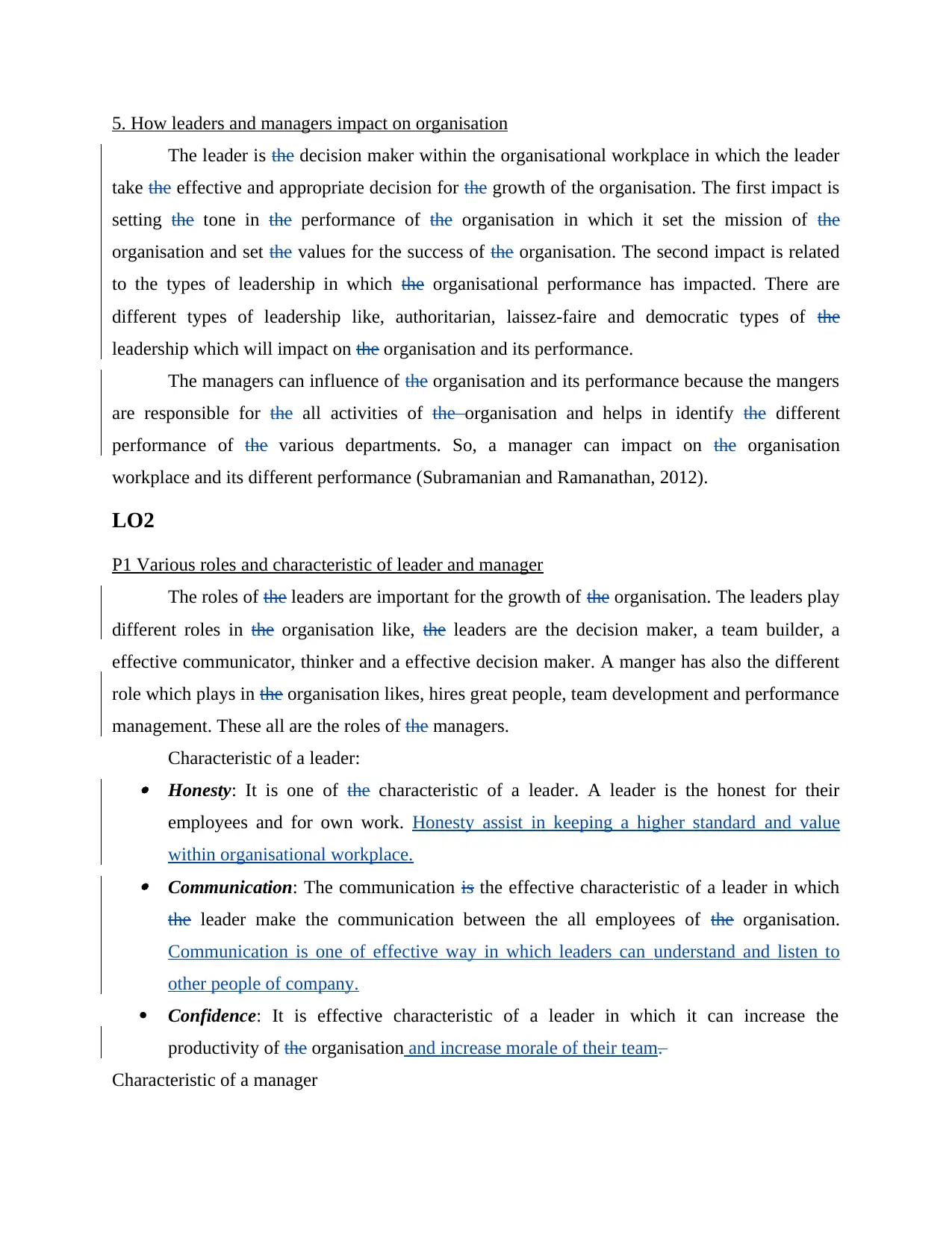
5. How leaders and managers impact on organisation
The leader is the decision maker within the organisational workplace in which the leader
take the effective and appropriate decision for the growth of the organisation. The first impact is
setting the tone in the performance of the organisation in which it set the mission of the
organisation and set the values for the success of the organisation. The second impact is related
to the types of leadership in which the organisational performance has impacted. There are
different types of leadership like, authoritarian, laissez-faire and democratic types of the
leadership which will impact on the organisation and its performance.
The managers can influence of the organisation and its performance because the mangers
are responsible for the all activities of the organisation and helps in identify the different
performance of the various departments. So, a manager can impact on the organisation
workplace and its different performance (Subramanian and Ramanathan, 2012).
LO2
P1 Various roles and characteristic of leader and manager
The roles of the leaders are important for the growth of the organisation. The leaders play
different roles in the organisation like, the leaders are the decision maker, a team builder, a
effective communicator, thinker and a effective decision maker. A manger has also the different
role which plays in the organisation likes, hires great people, team development and performance
management. These all are the roles of the managers.
Characteristic of a leader: Honesty: It is one of the characteristic of a leader. A leader is the honest for their
employees and for own work. Honesty assist in keeping a higher standard and value
within organisational workplace. Communication: The communication is the effective characteristic of a leader in which
the leader make the communication between the all employees of the organisation.
Communication is one of effective way in which leaders can understand and listen to
other people of company.
Confidence: It is effective characteristic of a leader in which it can increase the
productivity of the organisation and increase morale of their team.
Characteristic of a manager
The leader is the decision maker within the organisational workplace in which the leader
take the effective and appropriate decision for the growth of the organisation. The first impact is
setting the tone in the performance of the organisation in which it set the mission of the
organisation and set the values for the success of the organisation. The second impact is related
to the types of leadership in which the organisational performance has impacted. There are
different types of leadership like, authoritarian, laissez-faire and democratic types of the
leadership which will impact on the organisation and its performance.
The managers can influence of the organisation and its performance because the mangers
are responsible for the all activities of the organisation and helps in identify the different
performance of the various departments. So, a manager can impact on the organisation
workplace and its different performance (Subramanian and Ramanathan, 2012).
LO2
P1 Various roles and characteristic of leader and manager
The roles of the leaders are important for the growth of the organisation. The leaders play
different roles in the organisation like, the leaders are the decision maker, a team builder, a
effective communicator, thinker and a effective decision maker. A manger has also the different
role which plays in the organisation likes, hires great people, team development and performance
management. These all are the roles of the managers.
Characteristic of a leader: Honesty: It is one of the characteristic of a leader. A leader is the honest for their
employees and for own work. Honesty assist in keeping a higher standard and value
within organisational workplace. Communication: The communication is the effective characteristic of a leader in which
the leader make the communication between the all employees of the organisation.
Communication is one of effective way in which leaders can understand and listen to
other people of company.
Confidence: It is effective characteristic of a leader in which it can increase the
productivity of the organisation and increase morale of their team.
Characteristic of a manager
Paraphrase This Document
Need a fresh take? Get an instant paraphrase of this document with our AI Paraphraser

A manager are able to take the effective listening and build the cooperation relationship.
A manager has the technical knowledge for the better work within the organisation.
P2 How the role of the leader and function of manager is applied in various situations
The role of a leader and functions of a leader is applied on the different situation of the
organisational workplace (Peng and Lai, 2012). The organisational situations are as follows: Employees issues: It is one of the situation in which the role of a leader and function of a
manager is effective for minimising the issues which are related to the employees. The
employees includes, personality issues, personal issues, company structure issues and the
supervisor issues. Team problems: Tthe role of a leader and function of a manager are important for
reducing the team problems which is creating within the organisational workplace. The
leader and manager helps in increasing the performance of the team (Stadtler, 2015).
Organisation wide problems: The role of a leader and the function of a manager has
applied for reducing the different problems of the organisation. So, the effective leader
and manager play an important role in the organisational workplace.
P3 Various theories and models of approaches
There are different types of the theories and approaches of the leadership. They includes,
situational leadership, system leadership and contingency leadership are as follows: Situational leadership: The sSituational theory of leadership is important for taking the
effective decision within the organisational place and it is also required or the style of the
leadership. This leadership theory is focuses on the various situation of the organisation
and make the effective and efficient. System leadership: It is one of the theory of the leadership in which the organisational
leader is responsible for making the effective system within the organisational place and
provide the useful process or system to company (Akkerman, Farahani and Grunow,
2010).
Contingency leadership: This theory is based on the effectiveness of a leader in which it
identify the different situation for the different style of the leadership. The effective
leadership focuses on the effective qualities of the leaders and different style for the
particular situation of the organisation.
A manager has the technical knowledge for the better work within the organisation.
P2 How the role of the leader and function of manager is applied in various situations
The role of a leader and functions of a leader is applied on the different situation of the
organisational workplace (Peng and Lai, 2012). The organisational situations are as follows: Employees issues: It is one of the situation in which the role of a leader and function of a
manager is effective for minimising the issues which are related to the employees. The
employees includes, personality issues, personal issues, company structure issues and the
supervisor issues. Team problems: Tthe role of a leader and function of a manager are important for
reducing the team problems which is creating within the organisational workplace. The
leader and manager helps in increasing the performance of the team (Stadtler, 2015).
Organisation wide problems: The role of a leader and the function of a manager has
applied for reducing the different problems of the organisation. So, the effective leader
and manager play an important role in the organisational workplace.
P3 Various theories and models of approaches
There are different types of the theories and approaches of the leadership. They includes,
situational leadership, system leadership and contingency leadership are as follows: Situational leadership: The sSituational theory of leadership is important for taking the
effective decision within the organisational place and it is also required or the style of the
leadership. This leadership theory is focuses on the various situation of the organisation
and make the effective and efficient. System leadership: It is one of the theory of the leadership in which the organisational
leader is responsible for making the effective system within the organisational place and
provide the useful process or system to company (Akkerman, Farahani and Grunow,
2010).
Contingency leadership: This theory is based on the effectiveness of a leader in which it
identify the different situation for the different style of the leadership. The effective
leadership focuses on the effective qualities of the leaders and different style for the
particular situation of the organisation.
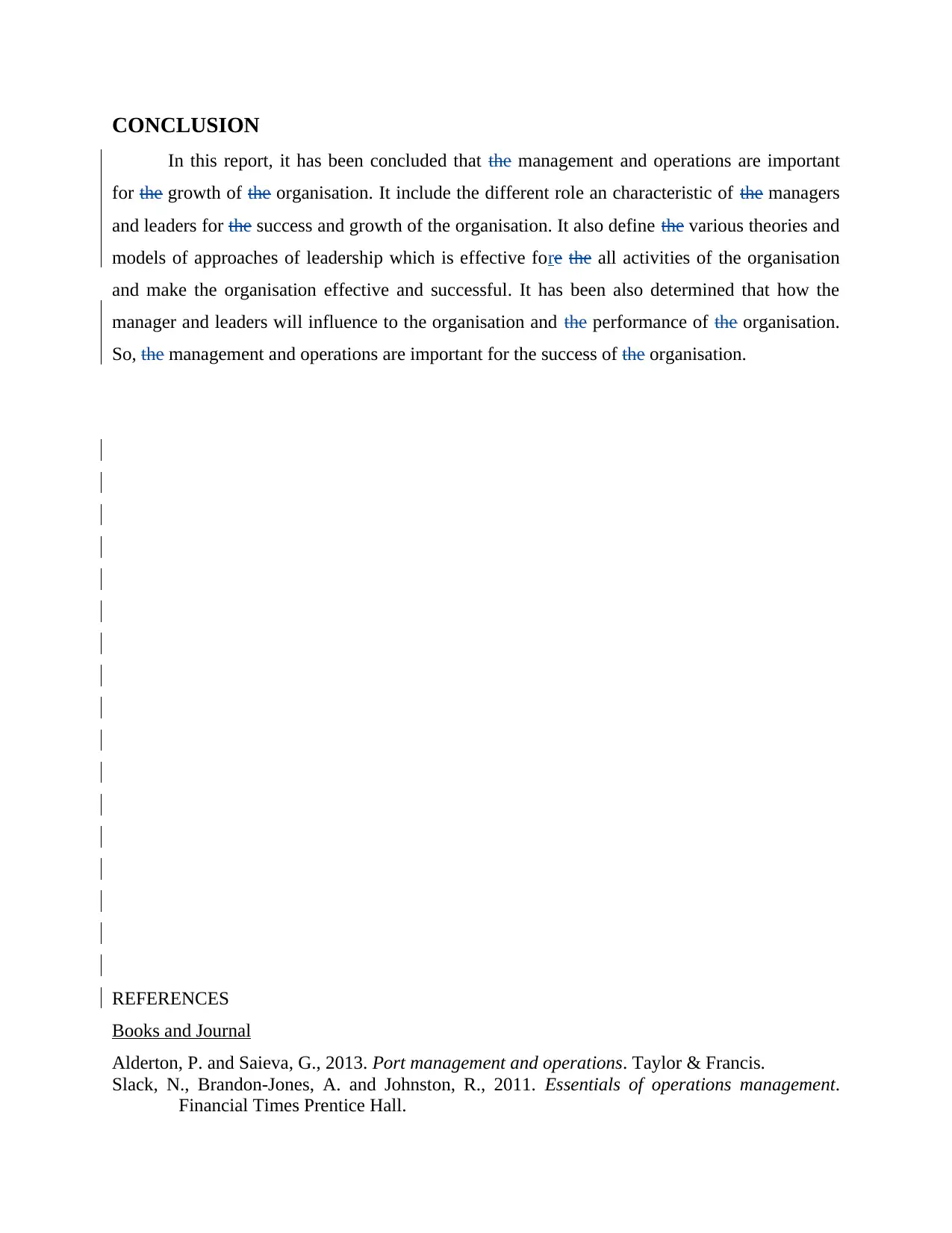
CONCLUSION
In this report, it has been concluded that the management and operations are important
for the growth of the organisation. It include the different role an characteristic of the managers
and leaders for the success and growth of the organisation. It also define the various theories and
models of approaches of leadership which is effective fore the all activities of the organisation
and make the organisation effective and successful. It has been also determined that how the
manager and leaders will influence to the organisation and the performance of the organisation.
So, the management and operations are important for the success of the organisation.
REFERENCES
Books and Journal
Alderton, P. and Saieva, G., 2013. Port management and operations. Taylor & Francis.
Slack, N., Brandon-Jones, A. and Johnston, R., 2011. Essentials of operations management.
Financial Times Prentice Hall.
In this report, it has been concluded that the management and operations are important
for the growth of the organisation. It include the different role an characteristic of the managers
and leaders for the success and growth of the organisation. It also define the various theories and
models of approaches of leadership which is effective fore the all activities of the organisation
and make the organisation effective and successful. It has been also determined that how the
manager and leaders will influence to the organisation and the performance of the organisation.
So, the management and operations are important for the success of the organisation.
REFERENCES
Books and Journal
Alderton, P. and Saieva, G., 2013. Port management and operations. Taylor & Francis.
Slack, N., Brandon-Jones, A. and Johnston, R., 2011. Essentials of operations management.
Financial Times Prentice Hall.
⊘ This is a preview!⊘
Do you want full access?
Subscribe today to unlock all pages.

Trusted by 1+ million students worldwide
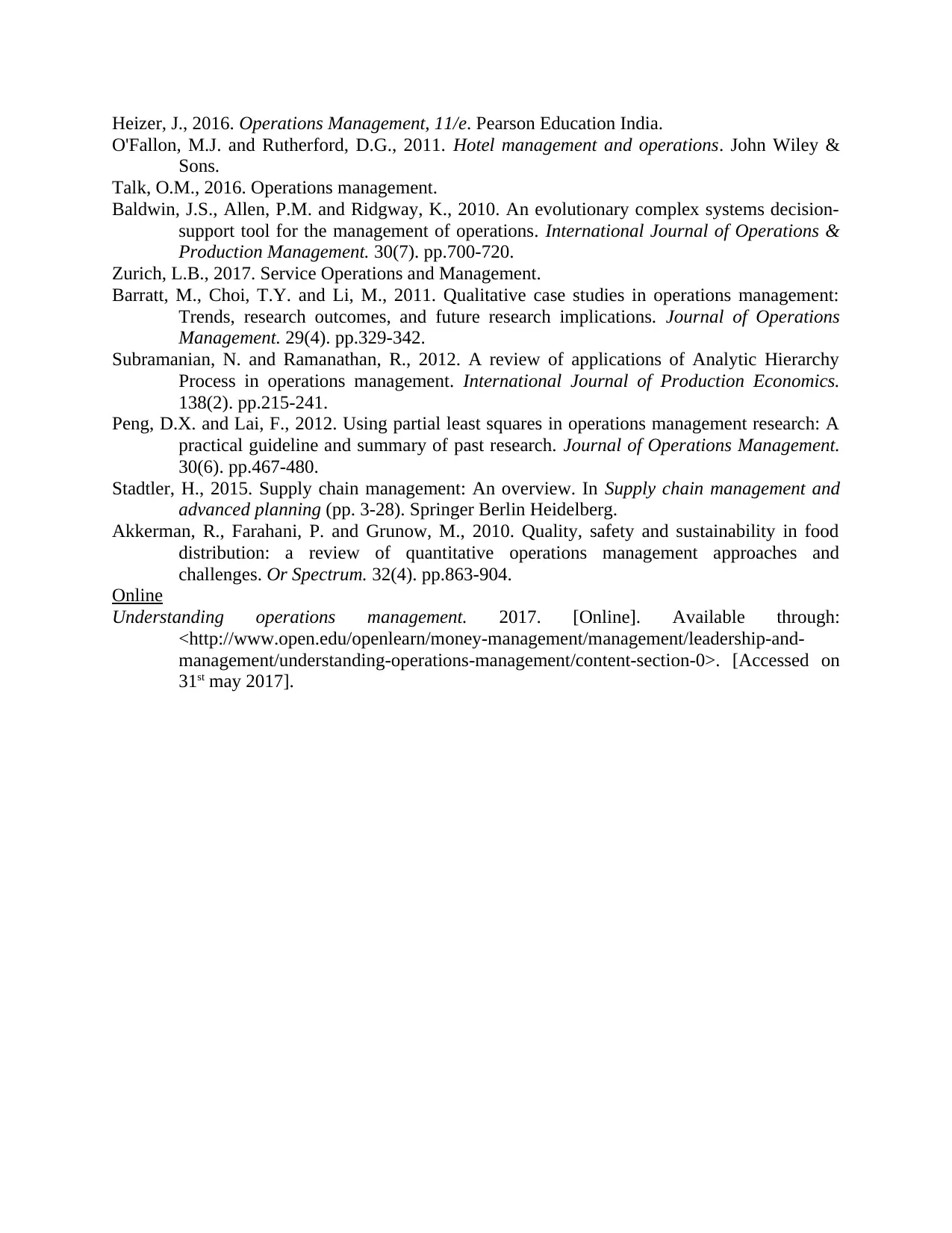
Heizer, J., 2016. Operations Management, 11/e. Pearson Education India.
O'Fallon, M.J. and Rutherford, D.G., 2011. Hotel management and operations. John Wiley &
Sons.
Talk, O.M., 2016. Operations management.
Baldwin, J.S., Allen, P.M. and Ridgway, K., 2010. An evolutionary complex systems decision-
support tool for the management of operations. International Journal of Operations &
Production Management. 30(7). pp.700-720.
Zurich, L.B., 2017. Service Operations and Management.
Barratt, M., Choi, T.Y. and Li, M., 2011. Qualitative case studies in operations management:
Trends, research outcomes, and future research implications. Journal of Operations
Management. 29(4). pp.329-342.
Subramanian, N. and Ramanathan, R., 2012. A review of applications of Analytic Hierarchy
Process in operations management. International Journal of Production Economics.
138(2). pp.215-241.
Peng, D.X. and Lai, F., 2012. Using partial least squares in operations management research: A
practical guideline and summary of past research. Journal of Operations Management.
30(6). pp.467-480.
Stadtler, H., 2015. Supply chain management: An overview. In Supply chain management and
advanced planning (pp. 3-28). Springer Berlin Heidelberg.
Akkerman, R., Farahani, P. and Grunow, M., 2010. Quality, safety and sustainability in food
distribution: a review of quantitative operations management approaches and
challenges. Or Spectrum. 32(4). pp.863-904.
Online
Understanding operations management. 2017. [Online]. Available through:
<http://www.open.edu/openlearn/money-management/management/leadership-and-
management/understanding-operations-management/content-section-0>. [Accessed on
31st may 2017].
O'Fallon, M.J. and Rutherford, D.G., 2011. Hotel management and operations. John Wiley &
Sons.
Talk, O.M., 2016. Operations management.
Baldwin, J.S., Allen, P.M. and Ridgway, K., 2010. An evolutionary complex systems decision-
support tool for the management of operations. International Journal of Operations &
Production Management. 30(7). pp.700-720.
Zurich, L.B., 2017. Service Operations and Management.
Barratt, M., Choi, T.Y. and Li, M., 2011. Qualitative case studies in operations management:
Trends, research outcomes, and future research implications. Journal of Operations
Management. 29(4). pp.329-342.
Subramanian, N. and Ramanathan, R., 2012. A review of applications of Analytic Hierarchy
Process in operations management. International Journal of Production Economics.
138(2). pp.215-241.
Peng, D.X. and Lai, F., 2012. Using partial least squares in operations management research: A
practical guideline and summary of past research. Journal of Operations Management.
30(6). pp.467-480.
Stadtler, H., 2015. Supply chain management: An overview. In Supply chain management and
advanced planning (pp. 3-28). Springer Berlin Heidelberg.
Akkerman, R., Farahani, P. and Grunow, M., 2010. Quality, safety and sustainability in food
distribution: a review of quantitative operations management approaches and
challenges. Or Spectrum. 32(4). pp.863-904.
Online
Understanding operations management. 2017. [Online]. Available through:
<http://www.open.edu/openlearn/money-management/management/leadership-and-
management/understanding-operations-management/content-section-0>. [Accessed on
31st may 2017].
1 out of 10
Related Documents
Your All-in-One AI-Powered Toolkit for Academic Success.
+13062052269
info@desklib.com
Available 24*7 on WhatsApp / Email
![[object Object]](/_next/static/media/star-bottom.7253800d.svg)
Unlock your academic potential
Copyright © 2020–2025 A2Z Services. All Rights Reserved. Developed and managed by ZUCOL.



